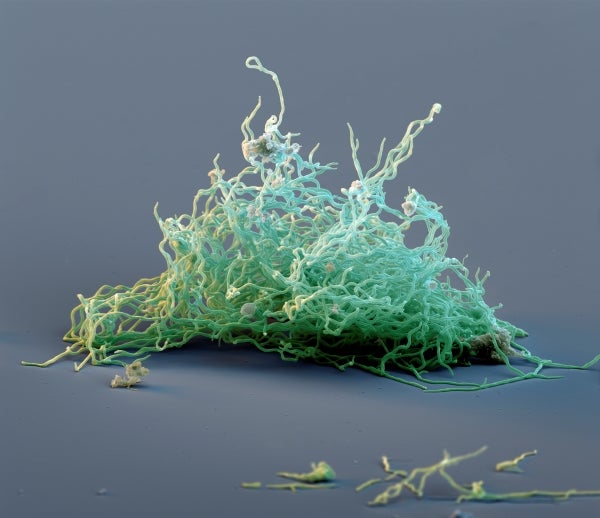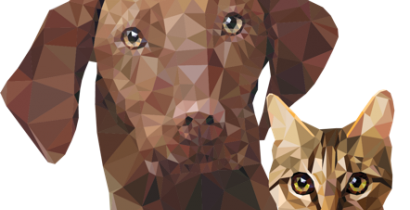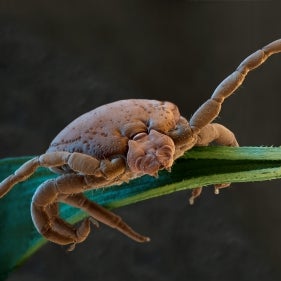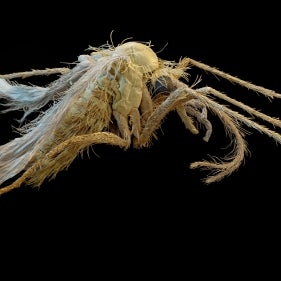Home -> Diseases -> All Diseases
DISEASES
Select a Disease
ALL DISEASES

Blood-feeding ectoparasites such as ticks, fleas, sand flies and mosquitoes can transmit many dangerous pathogens – e.g. bacteria, protozoa, viruses or helminths – to dogs and cats. They may lead to a variety of serious infections, grouped and labeled by their vectors: tick-borne diseases, flea-borne diseases, sand fly-borne diseases and mosquito-borne diseases, to name a few.
Different geographical regions have their own risks of infection. Nevertheless, seven major companion vector-borne diseases (CVBD) seem to have a worldwide impact: anaplasmosis, babesiosis, ehrlichiosis, heartworm disease, leishmaniosis, Lyme borreliosis and subcutaneous dirofilariosis.
These major companion vector-borne diseases are summarised in the table below.
Major canine diseases transmitted by vectors
| Pathogen | Ectoparasite/Vector | Pathogenesis/Clinics | Distribution |
| Anaplasma phagocytophilum | Ixodes spp. ticks US: Deer tick (I. scapularis) and Western black-legged tick (I. pacificus) | Infestation of white blood cells (neutrophils) Signs: fever, lethargy, weight loss, diarrhoea, vomiting, seldom bleedings and lameness | US: states in the north-eastern, mid-Atlantic, upper north-central regions, and north-western California Europe: northern and central countries like Germany, Czech Republic, Austria, Scandinavia, Scotland and many regions in eastern Europe including Russia |
| Anaplasma platys | Brown Dog tick (Rhipicephalus sanguineus) | Can infest platelets, thereby causing fever, depression and a bleeding tendency | Common in tropical and temperate regions |
| Pathogen | Ectoparasite/Vector | Pathogenesis/Clinics | Distribution |
| Babesia spp. | Ticks of several species; In Europe esp. the Ornate Cow tick (Dermacentor reticulatus) and the Brown Dog tick (Rhipicephalus sanguineus) | Infestation of red blood cells Signs: fever, lethargy, anorexia, anemia, red urine, splenomegaly, jaundice | Global Distribution Common in Africa, Europe, Asia, America, Oceania |
| Pathogen | Ectoparasite/Vector | Pathogenesis/Clinics | Distribution |
| Ehrlichia canis | Brown Dog tick (Rhipicephalus sanguineus) | Infestation of white blood cells (monocytes) Signs: fever, depression, lymphadenopathy, anorexia, weight loss, hair loss, lethargy, bleedings, eye signs | Widespread in tropical and temperate areas Reported from the USA, Europe (Mediterranean region) and Africa |
| Pathogen | Ectoparasite/Vector | Pathogenesis/Clinics | Distribution |
| Dirofilaria immitis | Mosquitoes (Aedes, Culex, Anopheles spp.) | Infestation of heart and lung Signs: weakness, lethargy and apathy, weight loss, dyspnea, coughing | Common in Southern Europe, US, Canada, Australia as well as South-eastern and Eastern Asia, including Japan Europe: prevalent in Portugal, Spain, Southern France, Italy, Greece and other peri-Mediterranean countries |
Lyme Borreliosis (Lyme Disease)
| Pathogen | Ectoparasite/Vector | Pathogenesis/Clinics | Distribution |
| Borrelia spp. | Ixodes spp. ticks, like Castor Bean tick (I. ricinus) in Europe; Deer tick (I. scapularis) and Western black-legged tick (I. pacificus) in the U.S. | Infestation of organs and connective tissues Signs: lameness, depression, fever, renal disease, cardiac disease, hepatic disease | US: states in the north-eastern, mid-Atlantic, upper north-central regions, and north-western California Europe: Germany, Switzerland, Czech Republic, Slovakia, Austria, Scandinavia, and many regions in Eastern Europe including Russia Occurrence also confirmed in Asia (China, Japan) and probably Australia |
| Pathogen | Ectoparasite/Vector | Pathogenesis/Clinics | Distribution |
| Leishmania infantum | Sand flies (Phlebotomus spp.), esp. P. perniciosus in the Mediterranean Region and Lutzomyia longipalpis in South America | Infestation of white blood cells in the bone marrow Signs: fever, anorexia, enlarged lymph nodes, wasting, lethargy, alopecia, skin lesions, eye signs, seldom liver and/or kidney failure, polyarthritis, diarrhoea | In more than 100 countries, from warm temperate through subtropical to tropical climates Extremely common in the Mediterranean area and South America; also found in Africa and Asia |
| Pathogen | Ectoparasite/Vector | Pathogenesis/Clinics | Distribution |
| Dirofilaria repens | Mosquitoes (Aedes, Culex, Anopheles spp.) | Infestation of the skin Signs: small and painless nodules | Common in Southern Europe, Middle East, Asia and Africa Europe: prevalent in Italy, Southern France, Portugal, Spain, Greece and Eastern Europe |
Ectoparasite control is an important measure to reduce the risk of CVBDs. Especially ectoparasiticides with not only acaricidal/insecticidal but additional repellent efficacy affect the arthropod-host interaction – including attachment and blood feeding – and thus reduce the risk of infection.
Prevention of tick attachment and flea, sand fly or mosquito bites must be an established tool of disease prophylaxis in pets living in vector endemic areas, or travelling with their owners to such regions. Dog and cat owners should be made aware of the risks and the need for protection by their veterinarians.

LOOKING FOR VECTORS?
You are looking for a specific vector, occuring in companion animals and capable of transmitting important companion vector-borne diseases (CVBD)?
Click hereEXPLORE OUR CONTENT
 CVBD MapsThe CVBD Occurence World Map presents country-specific situations based on current scientific knowledge and feed-back from experts around the world in an easy-to-grasped way. |
| Read more-> |
 ResourcesElanco Animal Health supports education in parasitology and especially in the field of vector-borne diseases. Access image collections, discover the World Forum calendar, interesting links and our glossary. |
| Read more-> |
 CVBD World ForumThe CVBD World Forum is a working group of leading international experts with the mission to enhance knowledge and communication on companion animal vector-borne diseases for the improvement of animal, human, and environmental health. |
| Read more-> |






